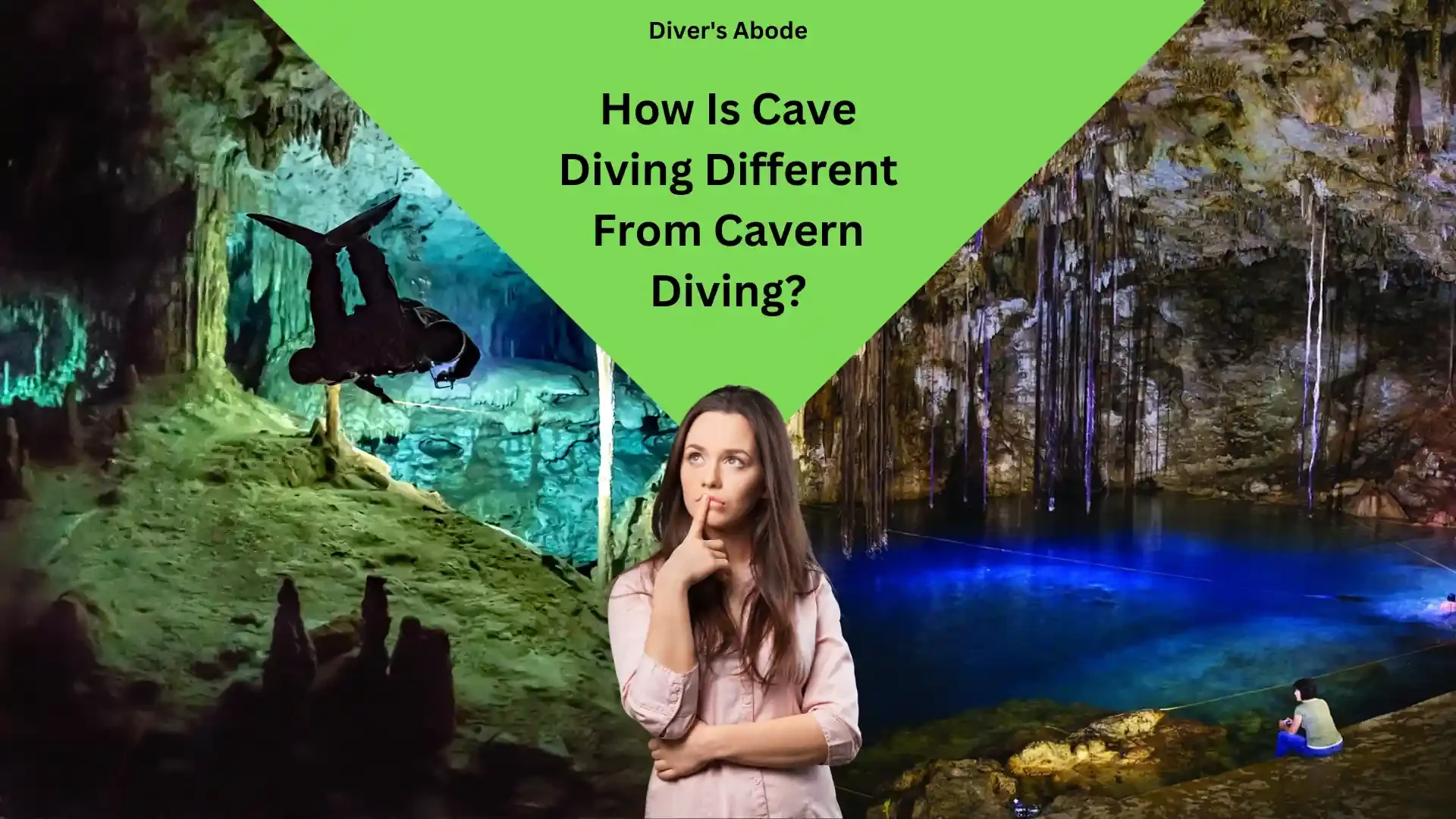Cave diving and cavern diving might sound similar but in practice, they are light years apart in terms of depth, safety protocols, expertise, and equipment needed.
Consequently, they each offer their unique benefits and pleasures. If you’re curious about the distinction between cave diving and cavern diving, you’ve come to the right place.
Table of Contents
An Explanation of Cave and Cavern Diving

A cavern is any area of the cave that is lit by sunlight from the outside, whereas a cave is any part of a cave that is completely devoid of any natural light. So naturally the diving experience in both environments is vastly different.
Cavern diving is basically a fancier form of recreational diving where you are surrounded by rock walls instead of open water. You don’t need special cavern diving certification to venture into one, your regular open-water certification is enough.
If you’re tired of seeing the same oceanic hue around you while scuba diving, you might want to try out cavern diving for a change of scenery.
Cave diving, on the other hand, is what I would describe as the “pinnacle of advanced diving”.
In simple words, you’re voluntarily trapping yourself in a pitch-dark enclosed space filled with water with your only options being moving forward or backward. If this doesn’t scare you enough you should check out the dangers associated with cave diving.
Not only does it require you to obtain advanced cave diving certification, this activity demands every last bit of your diving expertise and mental strength. If you’re experienced in cave diving, rest assured that no diving environment on this planet can scare you away, for you have already mastered the art of exploring the hardest of them all!
Cave divers often venture much deeper into the structure than cavern divers, who normally stay within 130 feet of the entrance and are in constant visual contact with it.
In the event of an emergency, cavern divers may always swim to the surface, making this style of diving more akin to recreational swimming than technical scuba.
Cavern Diving vs. Cave Diving
1. Certification
Any basic open-water certification from a recognized agency like PADI or SSI is suitable for Cavern diving. A few cavern diving destinations (especially cenote dive spots, more on that later) might require you to have advanced open-water and cavern diver certification. But in general, certification requirements for cavern diving are the same as recreational diving.
The same cannot be said about cave diving. Cave diving at PADI falls under distinctive specialty courses in technical diving certification. In simple words, you need to enroll in a technical diving course in which you will learn about cave diving as a special sub-discipline. There’s also a myriad of accessory courses you need to take like rebreather diver, cavern diver, technical side-mount, etc before enrolling.
The National Organization for Cave Diving (NADC) and the National Geographic Speleological Association Cave Diving Section (NSS-CDS) are just two of the many cave diving and technical diving organizations that certify cave divers, along with IANTD, TDI, GUE, and NAUI Tech.
2. Access to Natural Lighting:
Since cavern diving occurs mostly within sight of the entrance, cavern divers have access to natural light for the duration of their exploration. To add to that, some caverns have collapsed ceilings allowing them to open up to the sky and allow natural light to seep in. These types of caverns are also known as cenotes.
By sticking closer to the cave’s entrance, cavern divers increase their chances of making a direct exit from the cave system. In the event of an emergency, you should always be available to see the sunlight and should swim in that direction.
Things get a lot more dangerous while cave diving. It’s not uncommon for cave divers to travel hundreds of meters beyond the point where sunlight can enter to serve as a navigational aid. Besides, cave diving involves a lot of exploration in narrow underwater tunnels filled with water up to the enclosed cave ceiling. So naturally, these places lack any kind of light exposure. Your dive torch is your savior.
Whenever it comes to making a straight beeline escape to the cave entrance, cave divers are unable to achieve it with the same level of ease as a cavern diver.
3. Equipment Differs Vastly
Due to the lower risk associated with cavern diving compared to cave diving, the same gear used for open-water diving is generally used. Some small adjustments to gear are necessary for cave diving, but the experience may be just as rewarding as open-water diving.
Perhaps most obviously, a cavern diver employs a single tank with K-valves with only one regulator first stage for gas delivery.
On the other hand, cave divers have to wear special gear to protect themselves from the dangers that come with the territory every time they enter a cave.
At the heart of cave diving lies the cave diving tank called the ‘doubles’. To lay it simply, the ‘doubles’ are basically a pair of scuba tanks connected by a manifold with independent outlets for each tank.
A single source of breathing gas supplies two independent on/off switches including two regulator first stages, regardless of the number of tanks being used. If the O-ring connecting the valve to the regulator fails or the regulating swings into the circulation, the rest of the valve and regulator can be utilized to shut off the flow and allow the occupants to escape.
4. Surface Dive Stops
Unlike caverns or cenotes, caves are filled to the brim with water (both flowing and stagnant). Cave divers do not have the option to take a quick peek by breaking the water’s surface.
Now you might ask “But I have read there are air pockets in underwater caves!.” Not quite the truth. Yes, air pockets do form due to exhaled gases in caves frequented by divers. But those air pockets get filled up rapidly too. Cave explorer Xisco Gràcia had all the luck in the world to have found one of these temporary air pockets that ensured his survival while being trapped in the Mallorca caves.
The reality is that you might not be able to make a speedy ascent to the surface if you need to because a cavern continues to be an above environment. Furthermore, navigating a tunnel is distinct from navigating an open sea. To navigate a cavern, one must adhere to a fixed guideline that has been set up by trained cave divers.
Keep one hand near the line at all times, or near enough to grasp it swiftly if necessary. Your guide will give you a thorough pre-dive lecture and teach you correct cavern diving etiquette so that you can confidently and safely explore an underwater cavern. Real underwater cave exploration requires a comprehensive cave dive course.
5. Number of Restrictions Imposed
To ensure divers’ safety at all times during the thrilling underwater adventure, cave dive sites and cavern dive sites both have rules that must be followed. However, the rules that are enforced when you enter a cave or cavern will change based on which one you are exploring.
Cavern diving typically has a maximum penetration of 60 meters (200 feet) and a maximum depth of 21 meters (70 feet). At the outset, visibility is expected to be at least 15 meters (about 50 ft). There should be no need for decompression on any dive. In some parts of the cave, scuba divers aren’t permitted to swim side by side.
In general, cave divers will exceed one or more of the restrictions placed on them at a cavern dive site. Keep in mind that, because of the lack of visibility, a cavern dive at night is virtually the same as a cave dive, therefore the same dive site might be treated very differently depending on the time of day you enter it. And yet again, cave diving necessitates additional training for your protection.
6. Landscapes and Biodiversity
When you go between a cavern dive to a cave dive, you’ll notice some significant differences. You’ll enter an alien realm where the topography and wildlife are very different from what you’d see on a regular open-water dive.
The dark environments of caves and caverns are ideal for the survival and contentment of a wide variety of bizarre marine species. Animals lacking pigmentation, for instance, can seem very light in color or even white. Besides, many organisms exhibit bioluminescence, a phenomenon similar to deep sea creatures as both environments are devoid of natural sunlight. Many cave-dwelling organisms are also blind, so they rely on their lengthy feelers to help them find their way and find food.
Don’t Conflate Caves and Caverns
To wrap it up, cave diving is not everyone’s cup of tea. Exploring the majestic cenotes or well-lit-up caverns will never be the same as cave diving. Cave diving is entirely on another league on its own merit, but for people who are up for the challenge, it can be a fascinating and gratifying experience.
